The Pittsburgh & Lake Erie Railroad (P&LE), soon known as the “Little Giant,” opened between Pittsburgh and Youngstown in 1879. The railway traveled up the west bank of the Beaver River, crossed over to the east bank at Newport, passed through the yards at New Castle Junction, and continued along the northern bank of the Mahoning River towards Ohio. The P&LE soon built a small branch off the main line at New Castle Junction up to Pittsburg Street (later East Washington Street), where they built passenger station in about 1882. The small station, known as Union Depot or Union Station, was also utilized by various other railroads to include the Western New York & Pennsylvania (WNY&P), the Pennsylvania (PRR), the Pittsburgh & Western (P&W), and the Baltimore & Ohio (B&O). I believe the station was built by the P&LE, but the PRR (or “Pennsy”) possibly co-owned or came to co-own the station.
This Victorian-style train station was three stories in height and constructed primarily of red brick. The bottom floor contained the ticket offices and separate waiting rooms for the men and women, while the top two floors housed the various offices of the P&LE and PRR. The building was renovated and improved several times over the years, but by the end of the 19th century it was overcrowded and in need of a replacement. In December 1900, the P&W, which had previously allowed the PRR to sell its tickets, moved to its own passenger station a few blocks away at the corner of South Mill & Division Streets. It’s hard to imagine it now but the modern East Washington-Produce-Grove Street area was once home to a series of railroad tracks and quite busy with train traffic.
In 1899-1901 the P&LE spent about $70,000 acquiring parcels of property behind the station, extending all the way back to Cunningham Avenue (now Produce Street), with plans to lay a double track and improve its facilities in the area. The P&LE soon built a small rail yard in the area behind the station. As early as 1902 serious debate, spurred on by dissatisfied local rail customers, was started as to whether to enlarge the existing passenger station or build a new station altogether. In 1906 the B&O, who utilized the PRR tracks to reach Union Station, grew tired of disadvantageous situation (they were given low priority on the busy route and often delayed) and ceased service at the location – at least for a while. Meanwhile, the officials of the P&LE and PRR continued to discuss plans for a new passenger station, but the issue dragged on for some time.
The issue was apparently solved for them when a raging fire engulfed the station on the early morning of Tuesday, December 13, 1910. A small fire was discovered in the basement at about 2:00am and before too long the flames filled most of the building. Firemen from all over the city descended on the location and fought the blaze throughout the morning. They were hampered by the cold weather as the temperature hovered just below zero degrees and snow covered the ground. The streets around the area were literally covered in ice from the excess water used to fight the fire and hot ashes had to be spread around to prevent any injuries. No one was seriously injured during the effort, but the building was pretty much a total loss.
That same morning the PRR set up a temporary ticket office in a railroad car on a nearby siding, while the P&LE set up operation in their freight house. A few days later offices was set up in the baggage room, located at the rear of the old station, in addition to a new wooden structure built next to it. Business continued as usual while the P&LE and PRR mulled over options to either construct a new “joint” station, construct their own stations at the location, or relocate elsewhere in the city.
The PRR took the lead and decided to build a new passenger terminal at the same general location as the old Union Depot. In May 1913 the burned-out ruins of the Union Depot were finally cleared away as preparations were made to start work on the new station. Work commenced in late 1913 and the PRR station opened for business in early June 1914. At that time the temporary ticket offices, housed in the old baggage room and a wooden shack, were torn down. The P&LE erected a new freight station nearby, but moved its passenger service to the west side as it began leasing the old Erie Railroad station at the intersection of West Washington and Shenango Streets. The P&LE did not erect a new passenger station until it opened one in Mahoningtown – in conjunction with the B&O – years later in 1933.
The PRR station on East Washington Street, although passenger service as a whole declined steadily with the rise of the automobile in the 1920’s, remained in operation for many years. In April 1968 the PRR merged with the rival New York Central Railroad (NYC) to form the Penn Central Railroad (PCR), which continued to operate a few daily trains into the East Washington Street station until at least late 1970. It likely ceased service after the controversial commencement of operations by Amtrak, the government- owned corporation that took over (and downsized) all nationwide passenger service beginning on May 1, 1971.
I believe the former train station on East Washington Street sat vacant for some time until local businessman Carl Clark purchased it in 1982. He renovated the building (and a few others nearby) and it became the new home of a photography business known as Clark’s Studio. The building retains its historic feel and remnants of the railroad tracks around the building can still be seen today.
To read the schedules of the P&LE and PRR operating out of the station in early 1891 click on: 1891 SCHEDULES. To read about a special excursion train of the P&LE headed to Pittsburgh in early 1891 click on: WASHINGTON’S BIRTHDAY ARTICLE. To read about an upcoming effort to renovate the building in late 1892 click on: THOROUGH OVERHAULING ARTICLE. To read about three unruly men who caused quite a scene at the Union Depot in August 1894 click on: FIERCE FIGHT ARTICLE. To read the schedules of various trains departing from the station in August 1897 click on: 1897 SCHEDULES. To learn more about why the P&W stopped service at the Union Depot and opened its own passenger station in December 1900 click on: P&W TO USE ITS OWN DEPOT ARTICLE. To read about the P&LE’s major plans for its operations in New Castle in early 1901 click on: TERMINAL POINT ARTICLE. To read about a sick man taken from Union Depot to the hospital in June 1901 click on: TAKEN TO HOSPITAL ARTICLE. To read about the bitter B&O officials planning to cut service to the Union Depot and working on an alternate form of local transportation click on: TROLLEY SERVICE ARTICLE. To read an article trumping up the visit of P&LE and PRR executives in connection with building a new station in New Castle click on: NEW STATION FOR THIS CITY ARTICLE. To read about the devastating fire that consumed the Union Depot in December 1910 click on: UNION DEPOT GUTTED BY FIRE ARTICLE. To learn more about a group of local businessman that requested that the railroad companies quickly rebuild the Union Depot click on: ASK FOR NEW STATION ARTICLE. To learn more about a temporary train station (that would be in use for four years) erected a few days after the fire click on: TEMPORARY STATION ARTICLE. To read about the concern of the city about getting the railroads together to start planning a new station click on: CONFERENCE NOT CALLED ARTICLE. To read a short editorial poem criticizing the greedy railroad companies click on: RAILROAD POEM. To read a partly obscured article about the one year anniversary of the fire click on: FIRST ANNIVERSARY ARTICLE. To read about the effort to finally tear down the charred remains of the old station in May 1913 click on: COMING DOWN FAST ARTICLE. To read about the plans of the PRR and P&LE along East Washington Street in late 1913 click on: NEW STATION ARTICLE. To read about the temporary station being removed with the opening of the new PRR station in early June 1914 click on: LAST REMNANT OF STATION ARTICLE.
 This Victorian-style passenger terminal, known as Union Depot or Union Station, was built on Pittsburg Street (later East Washington Street) by the P&LE in c1882. It served as a passenger station on the New Castle Branch off the P&LE main line and was shared by various other railroads to include the PRR and B&O. There was serious talk of replacing this aging passenger station as early as 1902, but before anything was done it was destroyed by a fire in December 1910. A new station was built at his location by the PRR and opened in June 1914. (c1905) Full Size |
 This train station was three stories in height and constructed primarily of red brick. The bottom floor contained the ticket offices and separate waiting rooms, while the top two floors housed the various offices of the P&LE and PRR. (c1903) Full Size |
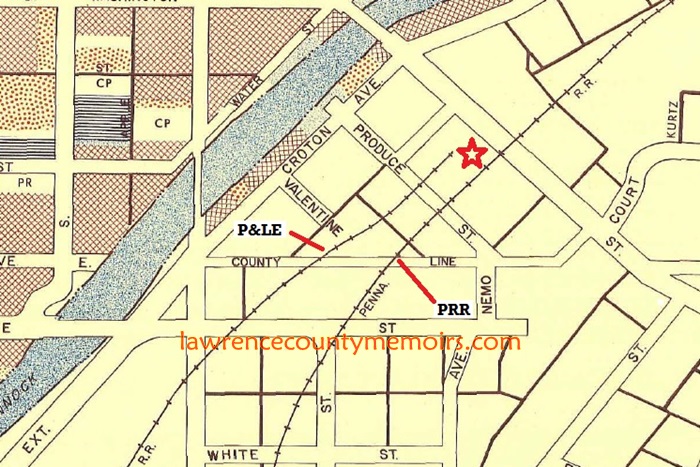 This map reveals the location of Union Depot on East Washington |
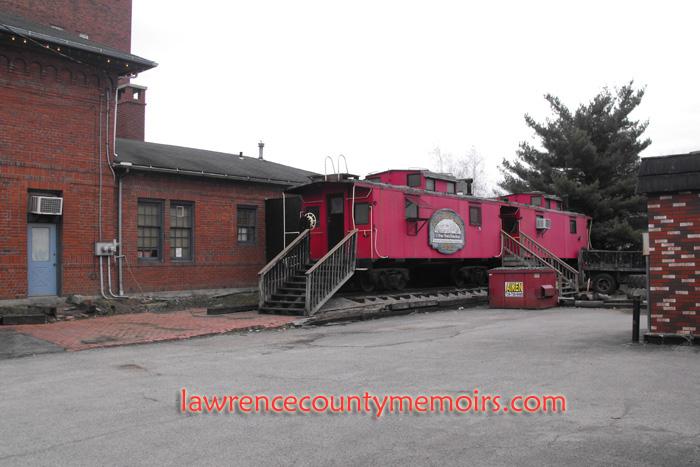 Several old train cars incorporated into Clark’s Studio. (Apr 2012) | 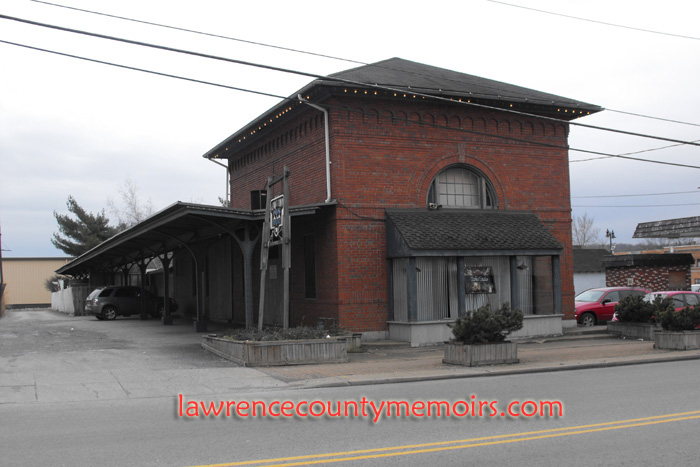 The front of the building facing East Washington Street. (Apr 2012) |
 The old platform shelter where folks would board the trains. (Apr 2012) |  Remnants of the old trains came still be seen on Produce Street just behind the former station. (Apr 2012) |
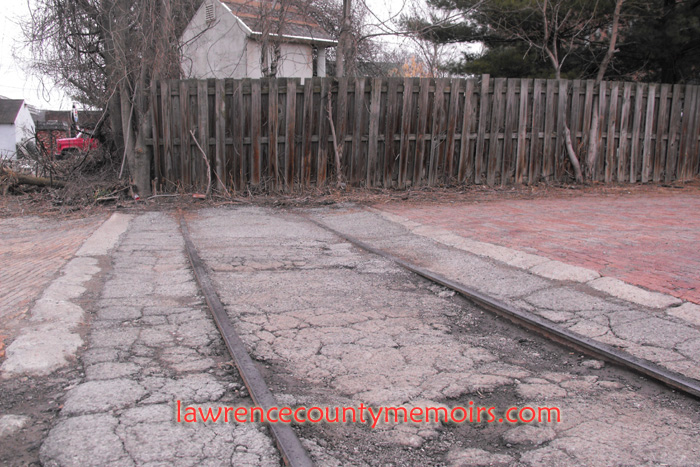 Abandoned tracks along Produce Street. (Apr 2012) |  Several tanker-like train cars sit at the end of the former P&LE line along Produce Street. (Apr 2012) |




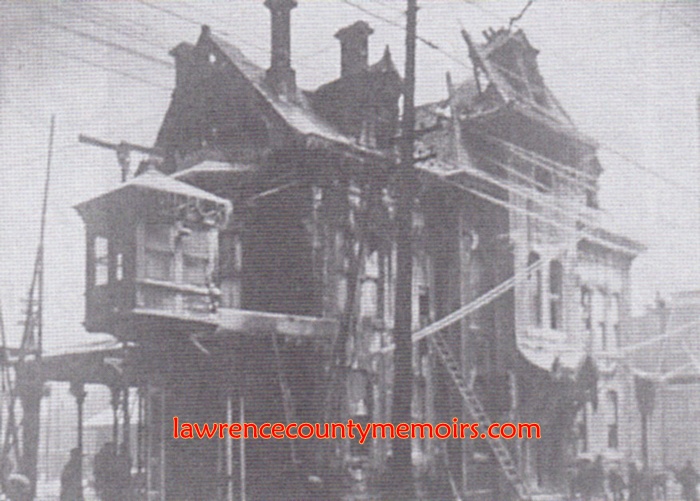
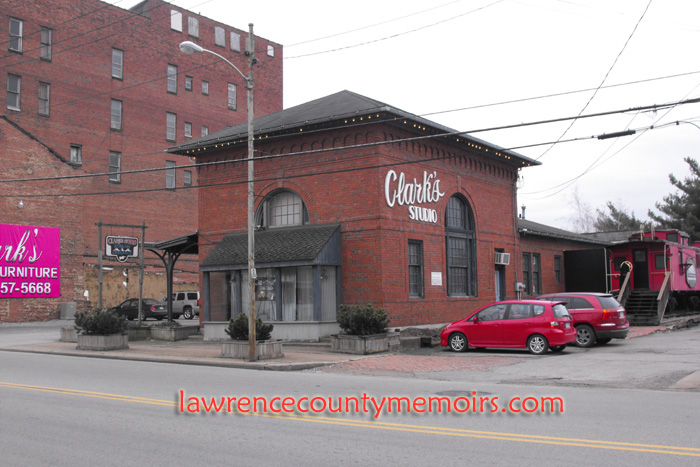

Comments
Denise Brooks #
Hello,
I enjoyed reading your great web page. My great grandfather worked for a local freight rail line referred to as the E & P Railroad. he was a conductor for 40 years and from newspaper articles I found he lived in New Castle 3 days a week and Erie the other days. Do you have any information about this rail line? thank you so much for your time.
Denise
Nathan Clark #
PRR Lines West
Erie & Pittsburgh Branch
by Alan B. Buchan
“After over 20 years of research and writing, this 247-page book contains over 400 photos and track diagrams, plus two large insert pages of maps. It describes the railroad from its conception in September 1835 to the present day. E&P was a north-south Iine that followed the Conneaut and Shenango River Valleys. Although it was not part of the PRR main line, it played an important role. Unfortunately, most is gone today.Chapters include history, expansion, success and atrophy, the city and port of Erie, photos from Erie to Homewood, freight and passenger operations, equipment and operation, and interfaces with connecting roads.
We are currently making a list of those interested in a (possible 2nd edition reprint). If interested, please call 610-683-7341 ext. 1005.”
Ray Danowski #
Hi Nate,
I am interested in purchasing a copy of the Buchan book and already called the number listed. I hope a second printing is coming!
Thanks.
Ray
Wayne Karns #
I was a child in New Castle back in the 50s. I remember the station was a produce market.
Comment